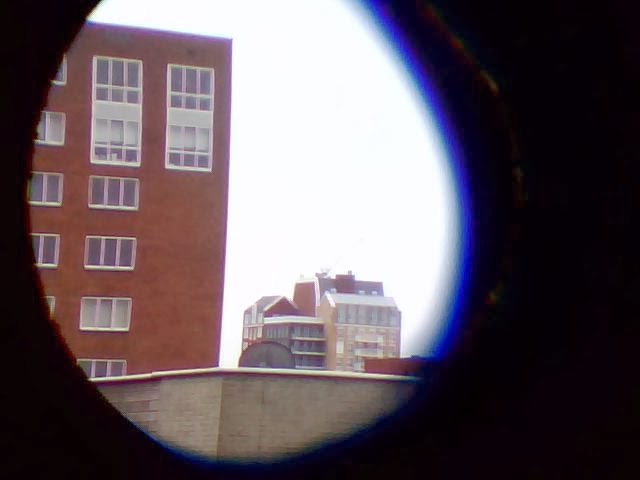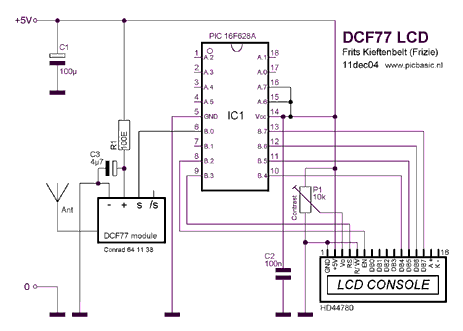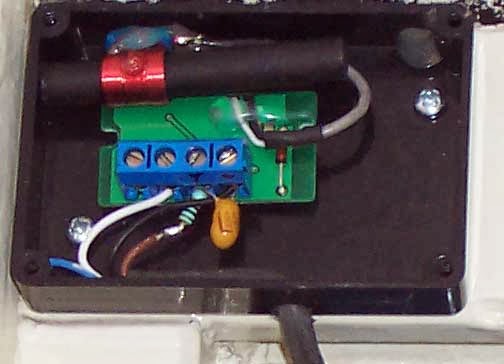I have categorized the main characteristics of most used IRF N-channel MOSFETs for RF purposes.
The table below might be useful for you when you are looking for the proper FET in your
MF/HF end stage.
FET Id Vds Rds Cin
A V ohm pF
===================================
IRF510 5,6 100 0,54 200
IRF520 9,7 100 0,2 330
IRF530 14 100 0,14 600
IRF540 33 100 0,04 890
IRF610 3,3 200 1,5 200
IRF620 7 200 1,2 460
IRF630 9 200 0,3 960
IRF640 18 200 0,15 1850
IRF710 2 400 3,6 200
IRF730 7 400 1 620
IRF740 10 400 0,55 1400
IRFs ending with IRFx10 have the smallest input capacitance: 200 pF
Those FETs can be used in PA's with operation frequency up till 15 MHz.
For MG experiments (appr. 500 kHz) I have succesfully used the IRF520 and IRF620.
Both work fine on this low frequency.
Input capacitance is often specified at Vds=25V and Vgs=0V.
Note: I have used various internet sources that were sometime controdictionary.
Thursday, 30 January 2014
Monday, 27 January 2014
Confirmation 10m FM QSO
John, EI2HM, from Tramore, Ireland has sent me an eQSL from a QSO in the summer of 2010.
This QSO was special since it was made in FM mode on 28 MHz. Propagation conditions must have been excellent since FM is not the easiest mode for long distance contacts.
This QSO was special since it was made in FM mode on 28 MHz. Propagation conditions must have been excellent since FM is not the easiest mode for long distance contacts.
eQSL
Tramore, South coast of Ireland
Sunday, 26 January 2014
Attic view, THz experiment
Just a simple optic experiment this afternoon (EM waves in frequency range of 430-790 THz); hooked up a binoculars to a low cost webcam.
This resulted in this view from my attic window:
Now more details (like the small segments in the windows) are visible that are not when glancing with the naked eye. A low budget 10 x 50 binoculars (from "Action" store) and a Trust Primo webcam were used. The webcam was applied onto the binoculars with ducttape.
Binoculars
Primo Trust Webcam
Next challenge will be to capture the moon with more visible details than with bare eyes. No radio licence required for those type of Extreme High Frequency experiments :-)
This resulted in this view from my attic window:
Binoculars
Primo Trust Webcam
Next challenge will be to capture the moon with more visible details than with bare eyes. No radio licence required for those type of Extreme High Frequency experiments :-)
Thursday, 23 January 2014
Time
Some years ago I looked for a simple clock to have an accurate time available in my shack.
I found a nice design on this website:
http://www.picbasic.nl/ => Projecten => Digitale DCF77 klok
I built the simple version (without sound) at the time and the clock is still working fine.
The clock uses a 16F628 PIC and a DCF77-module.
I selected a nice blue display to present the time.
DCF77 receive module
The longterm accuracy of the DCF clock is ok for normal use: After one year the deviation of the second is no more than +5 to +150 msec.
All about the 77.5 KHz DCF77 transmitter in Mainflingen:
http://en.wikipedia.org/wiki/DCF77
I found a nice design on this website:
http://www.picbasic.nl/ => Projecten => Digitale DCF77 klok
Circuit diagram DCF77 clock
I built the simple version (without sound) at the time and the clock is still working fine.
The clock uses a 16F628 PIC and a DCF77-module.
I selected a nice blue display to present the time.
DCF77 receive module
Clock in operation
All about the 77.5 KHz DCF77 transmitter in Mainflingen:
http://en.wikipedia.org/wiki/DCF77
Saturday, 18 January 2014
60 meter band RX results
The 60 meter band or 5 MHz band is a relatively new amateur radio allocation (not strictly a band), first introduced in 2002, that was originally only available in a few countries, such as the United States, United Kingdom, Norway, Finland, Denmark, Ireland and Iceland.
Lying approximately halfway between 80m (3.5 MHz) and 40m (7 MHz), the 60 meter (5 MHz) band forms a communication bridge when propagation effects make use of 80 or 40m impossible for local-to-medium distance communications.
Since in Holland we are not allowed to transmit in this band (yet), I tuned into the 60m band on the WSPR frequency 5.2872 MHz. Received G en OZ stations:
All about the 60 m band:
http://en.wikipedia.org/wiki/60-meter_band
Lying approximately halfway between 80m (3.5 MHz) and 40m (7 MHz), the 60 meter (5 MHz) band forms a communication bridge when propagation effects make use of 80 or 40m impossible for local-to-medium distance communications.
Since in Holland we are not allowed to transmit in this band (yet), I tuned into the 60m band on the WSPR frequency 5.2872 MHz. Received G en OZ stations:
All about the 60 m band:
http://en.wikipedia.org/wiki/60-meter_band
Minima
Ashar Farhan has launched his new design: The Minima. This is a QRP general coverage shortwave transceiver intented for homebrew purposes. Covered frequency range is 0-30 MHz and RF output is appr. 1 Watt. An additional PA must be used for easy operation.
A digital display enables you easy frequency adjustment. A Si570 is used in the (double) VFO. A high IF of 20 MHz is choosen. Parts of the design are also used in the famous BITX transceiver of Farhan.
"Manhattan" style buid-up
You can read everything about this nice rig here and join the mailing list:
http://www.phonestack.com/farhan/minima.html
Smart design of the Minima:
A digital display enables you easy frequency adjustment. A Si570 is used in the (double) VFO. A high IF of 20 MHz is choosen. Parts of the design are also used in the famous BITX transceiver of Farhan.
"Manhattan" style buid-up
You can read everything about this nice rig here and join the mailing list:
http://www.phonestack.com/farhan/minima.html
Smart design of the Minima:
Thursday, 16 January 2014
28 MHz propagation after sunset
Interesting to see how the 10 meter band behaves after sunset. Yesterday evening WSPR activity with G and D was seen on my QTH JO22gb. The path crossing the ocean was with K9AN earlier that evening during daylight. I used 5 Watts RF into a G5RV jr antenna.
When thinking about the amazing results of WSPR last years I sometimes have the idea that there must be an undiscovered phenomenon that enables us to make worldwide WSPR links with less than 100 mW RF power. How about curved shapes in the propagation layers (like parabolic mirrors) that focus/concentrate the RF energy at the receiving spots ?

When thinking about the amazing results of WSPR last years I sometimes have the idea that there must be an undiscovered phenomenon that enables us to make worldwide WSPR links with less than 100 mW RF power. How about curved shapes in the propagation layers (like parabolic mirrors) that focus/concentrate the RF energy at the receiving spots ?

Saturday, 11 January 2014
BITX20
This morning I blew away the dust on top of my homemade BITX20 transceiver. I built this device in 2008 at the clubstation PI4RAZ in Zoetermeer. If you look up BITX20 in the forum of www.pi4raz.nl you can recall all the details of this project at that time.
Home made BITX20 on top of Yaesu FT450
Manhattan style build-up
The BITX20 is capable of providing an RF signal between 5 and 10 Watts. In my design two IRF510 mosfets have been incorporated into the PA.
When switching on the device this morning, to my surprise, it worked immediately.
Hooked up the G5RV jr antenna and ATU and in an hour time I was able to make 3 QSO's:
IZ1GRH, Stefano, Nr. Milano, 14.217 MHz
IZ6FXP, Al, North-Italy, 14.250 MHz
C37SBX, Andorra, FIS special callsign, 14.215 MHz
This last contact was a nice suprise. This special event station from Andorra is only active during this weekend (11/12 Jan. 2014). It is a special event station related to the FIS World Cup.
Power Amp with 2 IRF510 MOSFETs
Home made BITX20 on top of Yaesu FT450
Manhattan style build-up
The BITX20 is capable of providing an RF signal between 5 and 10 Watts. In my design two IRF510 mosfets have been incorporated into the PA.
When switching on the device this morning, to my surprise, it worked immediately.
Hooked up the G5RV jr antenna and ATU and in an hour time I was able to make 3 QSO's:
IZ1GRH, Stefano, Nr. Milano, 14.217 MHz
IZ6FXP, Al, North-Italy, 14.250 MHz
C37SBX, Andorra, FIS special callsign, 14.215 MHz
This last contact was a nice suprise. This special event station from Andorra is only active during this weekend (11/12 Jan. 2014). It is a special event station related to the FIS World Cup.
Power Amp with 2 IRF510 MOSFETs
Subscribe to:
Comments (Atom)






















